

A global archive of independent reviews of everything happening from the beginning of the millennium
To send us a review you have written click here
Read our Copyright Notice click here
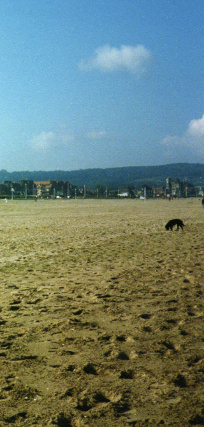
The Deauville beach, with the tide out, used for morning gallops
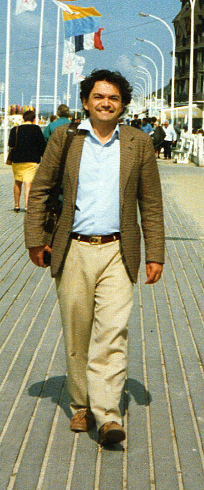
On the boardwalk or 'planches' at Deauville the day after the Prix Morny.
DEAUVILLE AND THE DUC DE MORNY
Reviewed by ANDRE BEAUMONT
2010 marked the 150th anniversary of the founding of Deauville and 2011 the 200th anniversary of its best known founder, the duc de Morny.
The anniversary of this town of 4000 inhabitants produced a book entitled Morny et l'Invention de Deauville at a symposium that year and it is from an excellent chapter in that tome by Maxime Jullien about horses and the history of the town from 1860 to 1939 in relation to them (Le Cheval a Deauville: une composante du developpement de la station, du duc de Morny a l'aube de la Seconde Guerre Mondiale) that much of the equine information given below is drawn.
As the introduction states, academics for long avoided writing about the duc de Morny for want of reliable sources.
This led, for instance, to a riveting but rum 'biography', Imperial Brother, by Maristan Chapman in 1931. In fact, it is part biography, part novel and Maristan Chapman is not a person at all but a man and a woman writing together under a pseudonym.
This is perhaps fitting for a subject of such intrigue. By multiple lines of illegitimacy, he quite possibly had more royal blood than his half-brother, the Emperor Napoleon III. He was the natural son of Queen Hortense, the daughter of the Empress Josephine. His father was the comte de Flahaut who was the natural son of Talleyrand and the comtesse de Flahaut who was natural daughter of Louis XV. Readers might prefer thoroughbred bloodstock lines where there is less possibility of error. In terms of dominance over his contemporaries he is up there with Dancing Brave. He orchestrated the coup that put his half-brother on the throne and in many ways he was the strong man behind the regime.
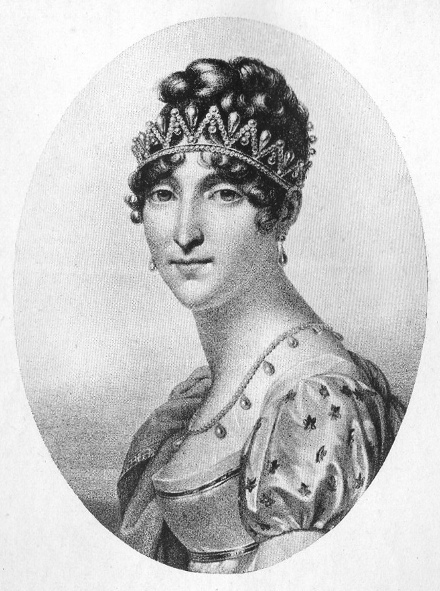
Queen Hortense of Holland
It is through the influence of an Irish quack, who had set up in Paris as Dr Olliffe, and became very fashionable, that he set out to create Deauville in his last years, acquiring marshland in the names of the doctor and a banker, Armand Donon, in 1859. Olliffe, well regarded as a founder, even the founder, had a villa in Trouville, the other side of the La Touques river, and did not like the parvenus moving to the town. So he pointed out the business opportunity to Morny and a resort based on three elements - luxury, proximity to Paris, and the business of racing was established at Deauville.
It had an excellent beach which continued beyond the municipal limits.
In 1860 an imperial decree authorised the creation of a port (a basin of 300 x 80 metres) and the extension of the Paris - Lisieux -Pont l'Eveque railway line to Deauville. The town's architect, Breney, became mayor in 1861.
In 1862 Morny was elevated to a dukedom having styled himself comte de Morny before. Morny brought cachet and knowledge of business, speculation and the world, not to mention art and racing.
Another of the chapters in the book explains Donon's role in Morny's financial affairs and he was probably the financial brains behind some of Morny's speculations. Due to this he was probably as important a founder as Morny and Olliffe. The arrival of the railway very greatly increased the value of the original land purchase and Morny, with his immense influence, was perhaps the only person who could embark on such a speculation secure in the knowledge that he could deliver a railway connection. The early development, including the founders' villas, proceeded on the kind of grand scale that showed confidence in the land value.
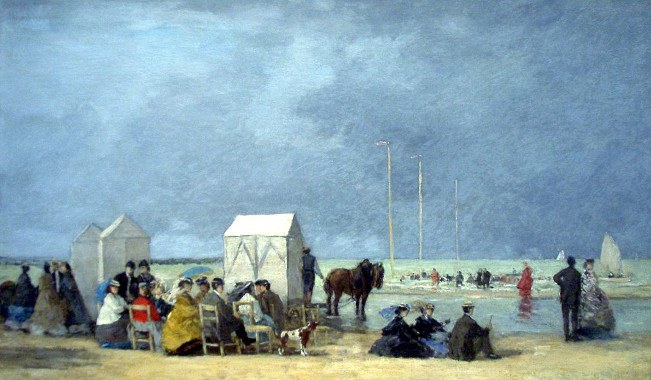
Eugène Boudin's Bathing Time at Deauville of 1865 - it was by then a fashionable resort
The racecourse de la Touques was built with a hinterland, the Pays d'Auge, that was very suitable for studs and training establishments and these duly arrived. The countryside benefited economically from Deauville and still does. The horses seem to benefit from it, too, as Julian Bedford has written:
Galloping on the beach in the morning, it is a break from their normal routine, and many horses thrive on their four weeks' holiday. Triptych, who made her name on the course as a two-year-old, is one in particular who used to benefit no end from her break by the sea.
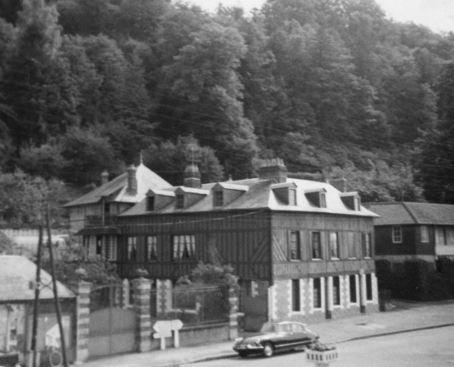
Pays d'Auge - known for a slow pace of life especially as telephones were few and never seemed to work
In the Maristan Chapman account Morny also turns to Olliffe as he is dying but needing to appear one more time in the legislature he presides over to pass some legislation vital to the regime:
"Dr Olliffe had time to reflect that he had best be thinking of a change of treatment. Arsenical pills might be very good for some complaints; but it would not be good to rely upon them entirely. He might lose a profitable patient"......
"Let me have some further prescription," Morny ordered. "There is only half a dozen left of your pellets."
"Already!" Dr Olliffe exclaimed startled back to consciousness. "My dear M. de Morny, you are exceeding - it is not safe - they are not good for you."
"Do you imagine I swallow your pills under the delusion they are curative? And they are safe to the extent that I know what poison they contain. Let me have them. It is no longer of consequence."
Dr Olliffe returned to the bedside. "All the same, he said, "one should live as long as possible."
"Not at all, said Morny. "Merely as long as necessary."
Alphonse Daudet, who had been secretary to Morny, wrote that his patients often died early whilst in full harness.
Morny was one of the founders of the French Jockey Club and Haussmann had come to Morny for support in influencing the Emperor to permit the building of the racecourse at Longchamps on the edge of Paris.
Deauville is certainly the classiest French resort on the Channel coast and Jullien says it still attracts an elite clientele in its summer season (which realistically ends after the last big race meeting of August though it is extended by the film festival), fashionable Paris and the wealthy for the yearling sales for which it is a renowned international centre.
Deauville also has an imposing casino and mooring for modest to medium sized yachts.
Deauville has had, since 1923, the planches running 623 metres along its sea front as its great symbol.
There is an internationally renowned polo ground to one side of the hippodrome de la Touques.
The nearby Pays d'Auge is replete with training establishments.
The first yearling auction took place in 1887. The regulation of betting on racecourses in 1891 was a further boost to the industry as it specified the percentage of takings to be paid to the racecourses allowing an increase in prize money.
In the twenties sale prices achieved for yearlings soared but between 1929 and 1930 total sales value dropped 45%, reflecting the crash on Wall Street, and for the remainder of the thirties 40% of the horses consigned for sale found no buyer.
For the period of the twenties, Jullien ranks Deauville with Newmarket as top of the global league for yearling sales ahead of Lexington.
From foundation in 1860 Morny insisted on the building of a grand racecourse, designed by Saint-Germain, and a racetrack was ready in October 1863. In the summer of that year a race meeting had been held on the sand of the beach in the presence of the duc de Morny and the Austrian ambassador's wife, Princess Metternich.
Occupying 75 hectares bordering the La Touques river, it is a set of flat racing courses. Its first course was opened on 15 August 1864, the feast day of the Emperor. (Napoleon I was born on 15 August). The casino and its grand hotel had opened the month before. The death of Morny in 1865 and the end of the regime five years later slowed up the development of Deauville except in equine matters which sustained its economy and gave justification to a luxurious resort.
Before the Great War race meetings had extended in length to eleven days from two in 1860. Following it much work went into a Nouvelle Deauville and the twenties were a period of economic expansion and something of a golden era for the town. By 1919 race meetings had already extended to fifteen days in length and Jullien mentions Winston Churchill as a visitor in 1922. Mornings were typically spent on the planches (made of azobe, a tough, red hardwood that turns a silver grey) and the afternoons on the racecourse. A further racecourse for jump racing was opened at Clairefontaine in 1928.
Jullien explains that before the war society had favoured Baden as a resort but after it Germany was neglected to Deauville's advantage. French rules forbad owners running horses in Germany and prominent figures in Deauville lobbied to have races transferred to Deauville.
1887 marked the authorisation of pari mutuel or tote style betting and prize money began to go up by about 50% compound per decade with a particular kick upwards after the war to the end of 1928.
Big races also characterised Deauville: the Prix Morny, Prix Maurice de Gheest, Prix Le Marois and Grand Prix de Deauville.
Betting volumes continued to grow until 1931, after which they fell off 40%.
Racing is an integral part of this resort to this day and that it should be so was the intention of its founders. Racing depends on the large number of visitors the resort can draw and in turn the resort depends on racing to entice them there or make them stay a few days or weeks. The capital of French racing in the twenties, Deauville lays a claim to be so today though this would be disputed by Chantilly.
Postscript 13 January 2013
As Triptych is mentioned I remember the Coral Eclipse Stakes at Sandown when Reference Point was unexpectedly beaten into second place by Mtoto with Triptych third, the loss being later attributed to a problem with a shoe. The field was exceptionally strong. Queen Elizabeth the Queen Mother was there somewhere. After the presentations the Senior Steward, Lord Fairhaven, wandered off with old Mr Joel, offering the latter his arm for support. (Louis Freedman owned Reference Point not Jim Joel who was a very well known owner).
I nipped back to the enclosure and found myself alone with Reference Point face to face across the rail. He seemed a bit miffed, being usually used to all the attention and there was nobody there at all, but he had a good nature and I had a good look at him. Derby, St Leger, King George VI and Queen Elizabeth Diamond Stakes and also William Hill Futurity, Dante Stakes and Great Voltigeur. Not bad. My favourite horse of all time for some reason. Not nearly as well remembered as Dancing Brave of the previous year but just about as great. Also the son of Mill Reef who was the first horse I ever placed a bet on - unfortunately on the occasion that he was racing Brigadier Gerrard. Reference Point went to stud in Japan but was not a sire of any note. I trust I've remembered it all right or nearly.
2016: Statue of Frankel given to the National Heritage Centre for Horseracing and Sporting Art in Newmarket by Prince Kalid Abdullah in memory of Sir Henry Cecil